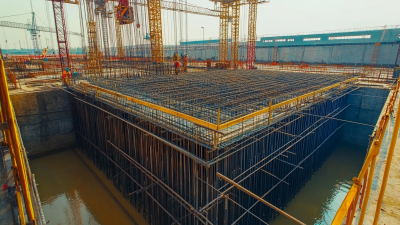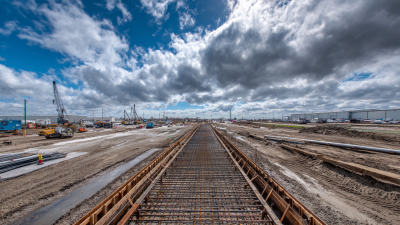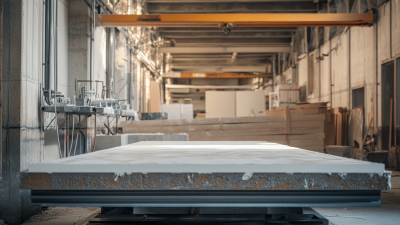In the ever-evolving construction industry, innovation is the key to achieving greater efficiency and precision. One of the most significant advancements in recent years is the introduction of Magnetic Formwork Products. These cutting-edge solutions are transforming the way construction projects are executed, allowing for quicker setups and improved structural integrity. By utilizing magnetic properties, these formwork systems eliminate the need for traditional fastening methods, resulting in a streamlined process that enhances productivity on job sites.
The adoption of Magnetic Formwork Products not only facilitates faster construction timelines but also minimizes material waste and labor costs. With their ability to conform easily to various design requirements, these products empower builders to achieve intricate and precise shapes without the usual constraints associated with conventional formwork. As we delve into the "Top 10" benefits of these revolutionary products, we will explore how they are setting new standards in construction efficiency and precision, paving the way for a more sustainable and innovative future in the built environment.

The construction industry is witnessing a transformative shift with the advent of magnetic formwork technology. This innovative approach not only simplifies the complex process of construction but also significantly improves the precision of structural elements. Traditional formwork systems are often cumbersome and susceptible to misalignment, leading to increased labor costs and project delays. In contrast, magnetic formwork offers a more streamlined solution, allowing for rapid assembly and adjustment on-site. This agility is particularly beneficial for projects requiring quick turnaround times.
Advances in magnetic formwork have also contributed to enhanced durability and versatility. These products are designed to withstand harsh construction environments while maintaining high levels of accuracy. The use of magnets eliminates the need for traditional fastening methods, reducing the risk of human error and ensuring consistent results. Moreover, the adaptability of magnetic formwork systems makes them suitable for a wide range of project types, from residential buildings to large-scale industrial complexes. As construction teams embrace this technology, they are not only improving efficiency but also pushing the boundaries of design possibilities.
Magnetic formwork products are transforming the construction industry by significantly enhancing efficiency and precision. One of the key benefits of using magnetic formwork is the reduction of setup time. Traditional formwork methods often require extensive labor and time for assembly, whereas magnetic systems can be quickly and easily positioned, allowing for faster project completion. Studies show that projects utilizing magnetic formwork can see up to a 30% reduction in labor costs, highlighting the financial advantages as well.
Additionally, magnetic formwork provides improved accuracy in achieving specified shapes and designs. The uniform pressure distribution and robust adherence to surfaces ensure that the concrete is consistently cast to the required precision. This level of accuracy not only minimizes material waste but also enhances the structural integrity of the finished product. Data indicates that using advanced formwork solutions can result in up to a 20% decrease in material waste across construction sites.
Tip: When adopting magnetic formwork technology, always ensure that your project specifications align with the unique advantages of this system. Doing so can maximize effectiveness while minimizing potential pitfalls. Furthermore, incorporating prefabrication techniques can further optimize project timelines and costs by reducing onsite labor requirements.
Magnetic formwork products are transforming the construction industry by significantly enhancing efficiency and precision. The chart above compares the average time saved between traditional and magnetic formwork systems, demonstrating the advantages of adopting magnetic technology in construction projects.
The construction industry is undergoing a significant transformation with the adoption of magnetic formwork products, which play a crucial role in precision engineering and quality control. According to industry reports, the global formwork market is projected to reach a value of $8.9 billion by 2026, reflecting a compound annual growth rate (CAGR) of 5.5%. This increase is largely attributed to the enhanced productivity and reduction in construction time afforded by innovative formwork solutions. Magnetic formwork, in particular, offers precise alignment, which is essential for ensuring the structural integrity and aesthetic appeal of finished projects.
In the realm of quality control, magnetic formwork provides a distinct advantage by simplifying the installation process and reducing the margin for error. With traditional formwork systems, misalignment can lead to costly revisions and affect overall project timelines. However, magnetic systems allow for rapid adjustments and firm adhesion to the construction surface, ensuring that each structure meets stringent quality standards. A recent study showed that projects utilizing magnetic formwork experienced a 30% improvement in accuracy and a 25% reduction in labor costs, further underscoring the transformative potential of this technology in modern construction practices.
The advent of magnetic formwork solutions marks a significant shift in construction methodologies, especially when compared to traditional formwork systems. Conventional formwork typically relies on wooden or metal frameworks that require extensive labor and time for assembly. This method often leads to potential inaccuracies, as misaligned components can affect the overall structural integrity and dimension precision of the final product. Furthermore, the disassembly and transportation of traditional formwork contribute to inefficiencies and higher costs.
In contrast, magnetic formwork offers a streamlined approach that enhances both efficiency and precision. These innovative systems utilize magnets to secure the formwork in place, allowing for rapid setup and adjustments without the need for additional tools or complicated assembly procedures. The adaptability of magnetic formwork ensures that it can easily conform to various geometries, promoting creative design while minimizing wastage. As a result, projects utilizing magnetic formwork can experience reduced lead times and improved accuracy, ultimately transforming construction practices for the better.
The impact of digitalization on magnetic formwork innovations is reshaping the construction industry by integrating advanced technologies that enhance efficiency and precision.
As machines become smarter with applied AI and automation, magnetic formwork systems are evolving beyond traditional methods. These innovative solutions leverage digital tools to
streamline the construction process, reducing time and minimizing errors. With predictive analytics and real-time data, contractors can optimize workflows, adjust plans dynamically, and ensure the highest quality in structural integrity.
Moreover, the trend toward digitalization in magnetic formwork reflects broader advancements across various sectors, including biotechnology and digital medicine. The implementation of multi-modal AI technologies aids in complex tasks such as drug discovery and medical imaging,
showcasing a parallel trajectory of innovation. As construction adopts similar digital approaches, the potential for improved project outcomes and economic benefits becomes increasingly evident.
By embracing these future technologies, the construction industry is poised to unlock new levels of productivity and quality, setting the stage for a transformative era.






